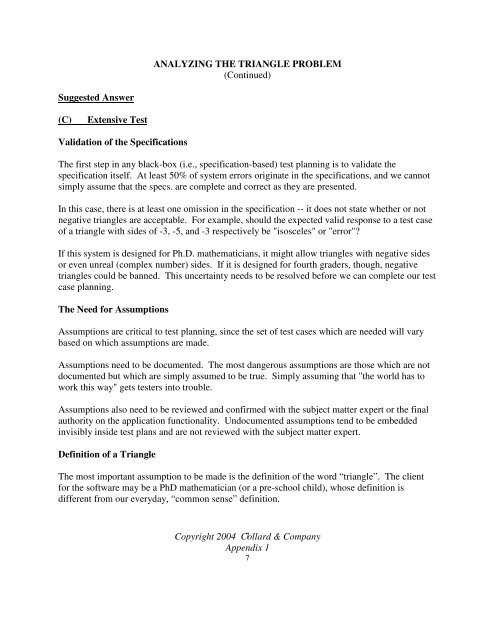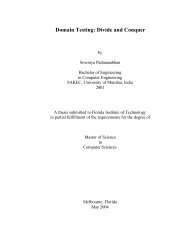appendix 1. analyzing the triangle problem - Testing Education
appendix 1. analyzing the triangle problem - Testing Education
appendix 1. analyzing the triangle problem - Testing Education
You also want an ePaper? Increase the reach of your titles
YUMPU automatically turns print PDFs into web optimized ePapers that Google loves.
Suggested Answer<br />
(C) Extensive Test<br />
Validation of <strong>the</strong> Specifications<br />
ANALYZING THE TRIANGLE PROBLEM<br />
(Continued)<br />
The first step in any black-box (i.e., specification-based) test planning is to validate <strong>the</strong><br />
specification itself. At least 50% of system errors originate in <strong>the</strong> specifications, and we cannot<br />
simply assume that <strong>the</strong> specs. are complete and correct as <strong>the</strong>y are presented.<br />
In this case, <strong>the</strong>re is at least one omission in <strong>the</strong> specification -- it does not state whe<strong>the</strong>r or not<br />
negative <strong>triangle</strong>s are acceptable. For example, should <strong>the</strong> expected valid response to a test case<br />
of a <strong>triangle</strong> with sides of -3, -5, and -3 respectively be "isosceles" or "error"?<br />
If this system is designed for Ph.D. ma<strong>the</strong>maticians, it might allow <strong>triangle</strong>s with negative sides<br />
or even unreal (complex number) sides. If it is designed for fourth graders, though, negative<br />
<strong>triangle</strong>s could be banned. This uncertainty needs to be resolved before we can complete our test<br />
case planning.<br />
The Need for Assumptions<br />
Assumptions are critical to test planning, since <strong>the</strong> set of test cases which are needed will vary<br />
based on which assumptions are made.<br />
Assumptions need to be documented. The most dangerous assumptions are those which are not<br />
documented but which are simply assumed to be true. Simply assuming that "<strong>the</strong> world has to<br />
work this way" gets testers into trouble.<br />
Assumptions also need to be reviewed and confirmed with <strong>the</strong> subject matter expert or <strong>the</strong> final<br />
authority on <strong>the</strong> application functionality. Undocumented assumptions tend to be embedded<br />
invisibly inside test plans and are not reviewed with <strong>the</strong> subject matter expert.<br />
Definition of a Triangle<br />
The most important assumption to be made is <strong>the</strong> definition of <strong>the</strong> word “<strong>triangle</strong>”. The client<br />
for <strong>the</strong> software may be a PhD ma<strong>the</strong>matician (or a pre-school child), whose definition is<br />
different from our everyday, “common sense” definition.<br />
Copyright 2004 Collard 7 & Company<br />
Appendix 1<br />
7








